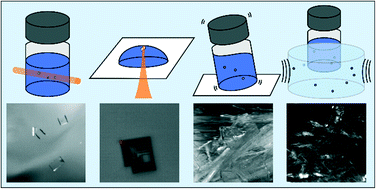Laser-induced nucleation promotes crystal growth of anhydrous sodium bromide†
Abstract
We report on a study of crystal hydrate formation in supersaturated aqueous sodium bromide using different methods to induce nucleation: mechanical shock-induced nucleation (MSIN), nucleation by ultrasound (sonocrystallization), non-photochemical laser-induced nucleation (NPLIN) and laser-trapping nucleation. The most stable crystal form at room temperature is known to be sodium bromide dihydrate (DH) and this form was favoured (>95%) through spontaneous nucleation or mechanical shock. Sonocrystallization favoured DH crystals (74%). Remarkably both laser-induced nucleation methods showed a strong preference (>90%) for anhydrous (AH) crystals. The nucleation mechanisms are discussed with reference to the solution–solid phase diagram. For laser-trapping nucleation, the results are consistent with previous studies showing that nucleation is preceded by formation of a localised volume of increased solute concentration. The common mechanistic feature linking sonocrystallization, MSIN and NPLIN is cavitation. The preference for AH sodium bromide suggests that nanosecond laser pulses produce cavitation events with more thermal energy compared to the other methods. The results demonstrate the value of laser-induced nucleation in controlling crystal hydrate growth and provide new understanding of the nucleation mechanisms.

- This article is part of the themed collection: Supramolecular & Polymorphism


 Please wait while we load your content...
Please wait while we load your content...